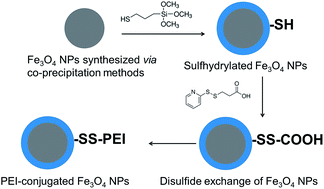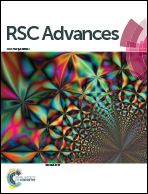Redox-responsive controlled DNA transfection and gene silencing based on polymer-conjugated magnetic nanoparticles
Abstract
Gene or DNA transfection is a non-viral tool for therapy on gene-based diseases by delivering nucleic acids into the target cells and change gene functions or protein expressions. The efficiency of gene transfection may be enhanced by magnetofection, which uses magnetic fields to concentrate magnetic nano-particles (MNPs) containing nucleic acid into the target cells. To protect from degradation after cellular uptake, MNPs are usually modified with cationic compounds such as polyethylenimine (PEI). After adsorption of plasmid DNAs onto the surface of positively charged MNPs, addition of extra free PEI is often required to form a ternary complex for magnetofection. It is because only the cationic compound could escape from the endosomes and transfers the nucleic acids into the cell nucleus, while the MNPs stay only in the perinuclear region. In this study, a redox-responsive disulfide bond was used to link 25 kDa PEI to MNPs, generating detachable PEIs for DNA protection, endosomal escape and nuclear entry. The as-synthesized MNPs were first wrapped in silica with thiol groups on the surface. After thiol exchange with 2-carboxyethyl-2-pyridyl disulfide, PEI was linked to the carboxyl groups with EDC/NHS chemistry. The magnetic gene carrier exhibited not only efficient DNA transfection but also a gene silencing effect as tested in both HeLa and HepG2 cells. After adding glutathione (GSH) as a trigger, plasmid DNA was released from the nanoparticles, confirming the redox-responsive property of the modified magnetic nanoparticles. The confocal microscopy images showed the labeled plasmid DNA located in the nucleus 3 h post-transfection, which was more obvious in 24 h after transfection. The co-localization of PEI and plasmid DNA in the nucleus confirmed the nucleic acids were taken in with the help of PEI, while nanoparticles remained in the perinuclear region. Our results demonstrate that the polymer-conjugated magnetic nanoparticles are effective DNA and siRNA carriers in vitro.


 Please wait while we load your content...
Please wait while we load your content...